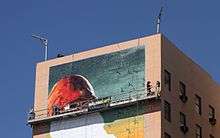Sign painting

Sign painting is the art of painting on buildings, billboards or signboards for the purpose of announcing or advertising products, services and events.
Sign painting is a learned craft with a long history. Historically artisans acquired the craft through apprenticeship, although many early sign painters were self-taught. An apprenticeship could last for years, depending on the skill of the apprentice and the knowledge of the master. The skills learned were varied, and some were complex. At the core of the training was proficiency in the manipulation of a lettering brush: this alone could take years to develop. A number of associated skills and techniques were also taught, such as gold leafing (surface and glass), carving (in various mediums), glue-glass chipping, stencilling, and silk-screening.
With the advent of computer software, sign painting has been displaced by computer-controlled sign-making machines. The craft has all but disappeared, and is now only still taught in a few technical schools or specialty schools.
Old painted signs which fade but remain visible are known as ghost signs.[1]
References
- ↑ "Défense D'Af: Faux Ghostsign from John Downer". Ghost Signs (blog). Retrieved 5 May 2016.
See also
External links
- Sign Painting Support Group - Providing answers about sign painting, its many facets, and its history
- Article on an exhibition of historical roadside signs in New England
- The Letterheads Website – The Keepers of our Craft – Sign Painting is alive and well!
- The Original Letterheads – A site maintained by one of the founders of the Letterhead movement
Digitised textbooks:
- Sign Writing and Glass Embossing (James Callingham, 1890)
- Lettering for Commercial Purposes (William Hugh Gordon, 1918)
- A Roman Alphabet and how to use it (Frank Forrest Frederick, 1917)
- David's Practical Letterer (Hackes & Binger, 1903)